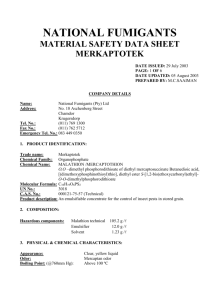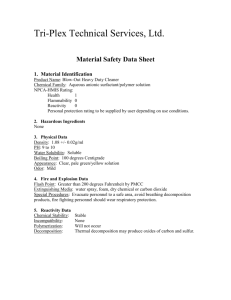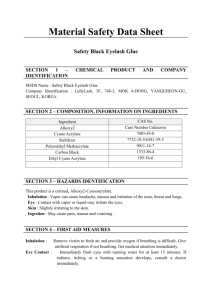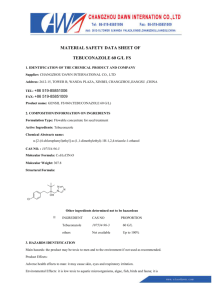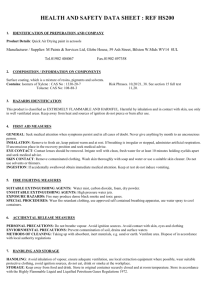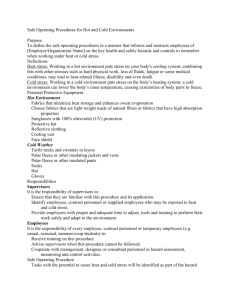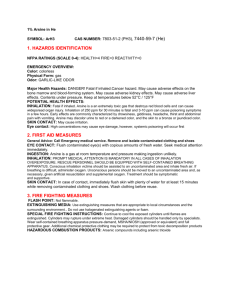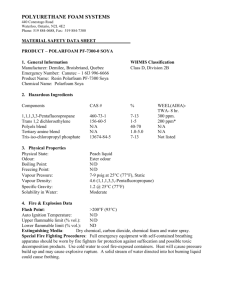Material Safety Data Sheets
advertisement
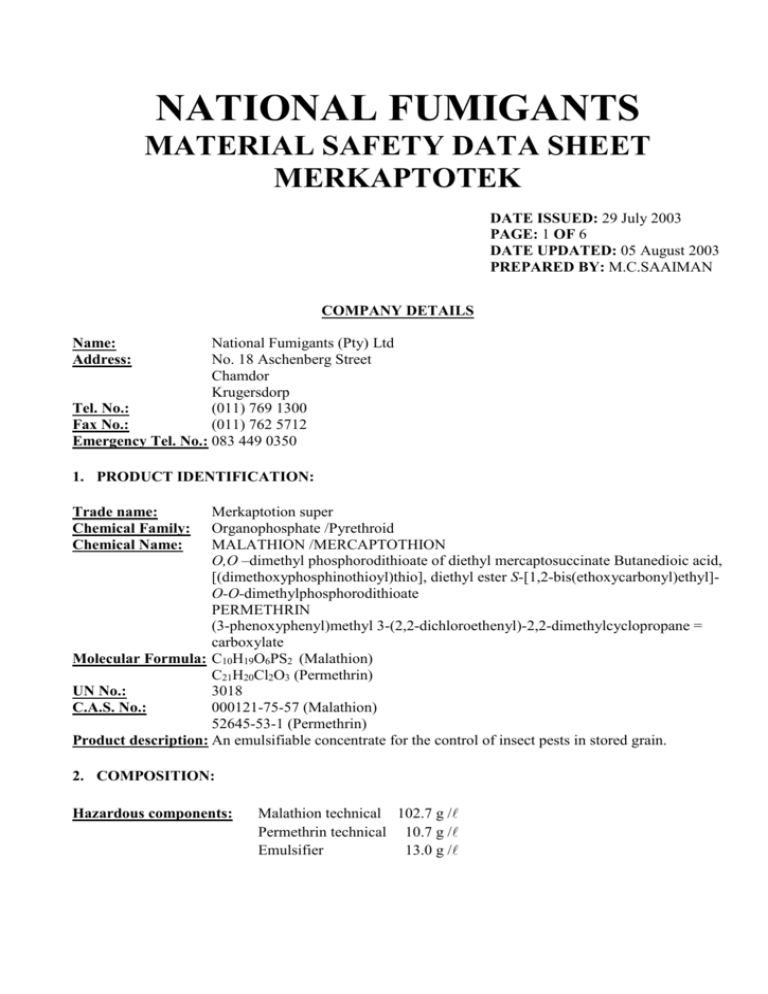
NATIONAL FUMIGANTS MATERIAL SAFETY DATA SHEET MERKAPTOTEK DATE ISSUED: 29 July 2003 PAGE: 1 OF 6 DATE UPDATED: 05 August 2003 PREPARED BY: M.C.SAAIMAN COMPANY DETAILS Name: Address: National Fumigants (Pty) Ltd No. 18 Aschenberg Street Chamdor Krugersdorp Tel. No.: (011) 769 1300 Fax No.: (011) 762 5712 Emergency Tel. No.: 083 449 0350 1. PRODUCT IDENTIFICATION: Trade name: Chemical Family: Chemical Name: Merkaptotion super Organophosphate /Pyrethroid MALATHION /MERCAPTOTHION O,O –dimethyl phosphorodithioate of diethyl mercaptosuccinate Butanedioic acid, [(dimethoxyphosphinothioyl)thio], diethyl ester S-[1,2-bis(ethoxycarbonyl)ethyl]O-O-dimethylphosphorodithioate PERMETHRIN (3-phenoxyphenyl)methyl 3-(2,2-dichloroethenyl)-2,2-dimethylcyclopropane = carboxylate Molecular Formula: C10H19O6PS2 (Malathion) C21H20Cl2O3 (Permethrin) UN No.: 3018 C.A.S. No.: 000121-75-57 (Malathion) 52645-53-1 (Permethrin) Product description: An emulsifiable concentrate for the control of insect pests in stored grain. 2. COMPOSITION: Hazardous components: Malathion technical 102.7 g / Permethrin technical 10.7 g / Emulsifier 13.0 g / DATE ISSUED: 29 July 2003 PAGE: 2 OF 6 DATE UPDATED: 05 August 2003 PREPARED BY: M.C.SAAIMAN 3. PHYSICAL & CHEMICAL CHARACTERISTICS: Appearance: Odor: Boiling Point: (@760mm Hg): Melting Point: Specific Gravity: Solubility: Clear, yellow liquid Mercaptan odor Above 100 ºC N/A 1.18 g / @ 20 ºC (formulation) Emulsifies with water 4. FIRE & EXPLOSION HAZARD DATA: Flammable limits in air:(% by vol.) Not available. Decomposition Temperature: For technical: Slow decomposition above 49ºC. Acute hazards: Combustible. Formulation contains organic solvents that is slightly flammable when exposed to heat /flame. Gives of irritating or toxic fumes (or gases) in a fire. Prevention: Keep away from open flames. Fire extinguishing media: Water, foam, dry chemical or CO2. Fire control precautions: Wear self –contained, positive pressure breathing apparatus and full fire fighting clothing. Keep unnecessary people away. Use as little water as possible. Prevent pesticide run –off. Use spray or fog –solid stream may cause spreading. Do not contaminate personnel or equipment, or handle broken packages or containers without protective clothing. Decontaminate emergency personnel with soap and water before leaving the fire area. Avoid breathing dusts, vapors and fumes from burning materials. Control run –off water –if water enters drainage system, inform Local Authorities. Fire fighting from maximum distance. 5. REACTIVITY DATA: Stability: Conditions to avoid: Stable Can react with oxidizing materials OR (H2SO4 + HNO3), N2O4, AgClO4. Storage at 50 – 115 ºC leads to non –hazardous decomposition. Heating at >150 ºC cause rapid decomposition. Reactivity with strong base may generate excessive heat. DATE ISSUED: 29 July 2003 PAGE: 3 OF 6 DATE UPDATED: 05 August 2003 PREPARED BY: M.C.SAAIMAN 5. REACTIVITY DATA: (continue) Incompatible materials: Hazardous decomposition products: Strong alkali’s and strong oxidizers. Thermal decomposition may produce hydrogen sulfide, methyl mercaptan dimethyl sulfide, carbon oxide, and sulfur oxide, phosphorous oxide. 6. HEALTH HAZARD DATA: TOXICITY DATA & EFFECTS OF OVEREXPOSURE: Acute toxicity data (for technical material): Oral LD50: Male rats = 2 800 mg /kg Female rats = 1 000 mg /kg Dermal LD50: Rabbits = 4 100 mg /kg Product not irritating to rabbit eye, but is slightly irritating to the rabbit skin. Inhalation exposure is not likely to produce any significant effects, due to low vapor pressure of the product. Acute hazards /symptoms: Inhalation: Headache, dizziness, papillary constriction, muscle cramps, excessive sweating, laboured breathing, unconsciousness. The symptoms of acute intoxication do not become manifest until before 30 minutes or 1-2 hours. Skin: Headache, dizziness, papillary constriction, muscle cramps, excessive sweating, laboured breathing, unconsciousness. The symptoms of acute intoxication do not become manifest until before 30 minutes or 1-2 hours. Irritation to skin. Will cause dermatitis after prolonged exposure. Eyes: Irritation, redness. Ingestion: Abdominal cramps, diarrhea, nausea, vomiting, headache, dizziness, pupilliray constriction, muscle cramps, excessive sweating, laboured breathing, and unconsciousness. The symptoms of acute intoxication do not become manifest until before 30 minute or 1 – 2 hours. Prevention: Inhalation: Skin: STRICT HYGIENE! PREVENT GENERATION OF MISTS! AVOID EXPOSURE OF ADDOLESENTS AND CHILDREN. Administer a Cholinesterase blood-testing program. Area must be well ventilated. Wear a pesticide cartridge respirator when exposed to the product. STRICT HYGIENE! Wear rubber gloves. Boots and an apron or impermeable covering should be worn where splashing could occur. Wear a long sleeve or shirt and a full – length pants and overall. Shower at the end of the workday and change clothing. Launder clothing before re –use. DATE ISSUED: 29 July 2003 PAGE: 4 OF 6 DATE UPDATED: 05 August 2003 PREPARED BY: M.C.SAAIMAN 6. HEALTH HAZARD DATA: (continue) Eyes: STRICT HYGIENE! Wear chemical goggles to prevent eye exposure. Ingestion: STRICT HYGIENE! Do not eat, drink or smoke during work. Wash hands before eating or smoking. Emergency & First Aid Procedures: IN ALL CASES CONSULT A DOCTOR!! Inhalation: Remove victim to fresh air. Administer oxygen if there is difficulty in breathing. Give artificial respiration if person is not breathing. Refer for medical attention. Skin: Remove contaminated clothing. Wear impervious gloves. Rinse and then wash skin with water and soap. Do not omit cleansing hair or under fingernails if contaminated. Administer oxygen if there is difficulty in breathing. Give artificial respiration if person is not breathing. Refer for medical attention. Eyes: Flush eyes with copious amounts of tap water for at least 15 minutes, while holding the eyelids open. Refer for medical attention. Ingestion: If water diluted mixture has bee swallowed, induce vomiting by tickling the back of the throat. If concentrate has been swallowed, firstly administer copious quantities of either beaten egg white, starch solution or Milk of Magnesia, before induce vomiting. Repeat until vomit fluid is clear and free from smell of poison. Apply artificial respiration or closed chest cardiac massage, if necessary. Never give anything by mouth to an unconscious person. Do not apply mouth – to – mouth respiration. Refer for medical attention. NOTE TO PHYSICIAN: Product may inhibit Acetyl Cholinesterase activity. Administer Atropine Sulphate, intravenously (1 – 4 mg) every 5 – 10 minutes until signs of atropinization (dry, flushed skin and tachycardea). 2 – PAM 50 mg /kg up to a total dosage of 1 – 2 g, or 2/3 of this dose Protopam. Repeat if necessary. Never give Morphine. Clear chest by postural drainage. Artificial respiration or oxygen administration may be necessary. 7. EXPOSURE CONTROL METHODS: During formulation the following good industrial hygiene practice is recommended: When transferring material from one container to another, or where splash hazard exists, wear chemical goggles to prevent eye exposure. Wear rubber gloves when handling this material. An apron or impermeable covering should be worn where splashing could occur. A long –sleeved shirt, boots, and full-length pants (or overalls) should also be worn. DATE ISSUED: 29 July 2003 PAGE: 5 OF 6 DATE UPDATED: 05 August 2003 PREPARED BY: M.C.SAAIMAN 7. EXPOSURE CONTROL METHODS: (continue) Wash thoroughly with soap and water after handling. Remove contaminated clothing and wash before re –use. Wear a pesticide cartridge respirator when exposed to vapor. Administer a cholinesterase blood-testing program at work. 8. WARNINGS: Grain treated with Merkaptotion super according to instructions is entirely suitable for human and animal consumption. Handle Merkaptotion super with care. Store away from food and feedstuffs. Poisonous if swallowed, by contact on inhalation. Keep out of reach of children, uninformed persons and animals. 9. PRECAUTIONS FOR SAFE HANDLING & USE: Spill or leak procedures: Waste disposal: Wear appropriate protective clothing, dike spill area to prevent product release, absorb with an inert absorbent material, (e.g. granular clay or sawdust), and shovel or sweep into covered containers for proper disposal. Rinses spill area and tools several times with soapy water. Contain and absorb rinsate with inert absorbants and place into the same disposal container as spill residues. Small spills to the soil can shovel directly into disposal containers. If spill is to a water body, notify Local Authorities immediately. To avoid disposal, all should be made to utilize the product completely, in accordance with it registered use. If this is not possible, handle with care, and dispose in a safe manner according to Local regulations, regarding Waste Management. Empty containers with some product residues, should NOT BE RE – USED! Triple rinse empty containers and add rinsings to the spray tank. Render container unusable by crushing and / puncturing, and dispose in a safe manner. DATE ISSUED: 29 July 2003 PAGE: 6 OF 6 DATE UPDATED: 05 August 2003 PREPARED BY: M.C.SAAIMAN 9. PRECAUTIONS FOR SAFE HANDLING & USE: (continue) Precautions –Handling /Storage: Do not inhale spray mist. Wash contaminated clothing after the day’s work. Wash after accidental skin contact with soap and water. Do not eat, drink or smoke whilst mixing or applying or before washing hands and face. Do not contaminate water, food, or feed by storage or disposal. Store in a secure, dry, well –ventilated separate room, building or covered area. Destroy non –returnable containers by perforation and do not re –use for any other purpose. Do not remove labels from returnable containers. Keep away from sources of ignition and protect from exposure to fire and heat. Separate from strong oxidizers, food and foodstuffs. 10. TRANSPORTATION DATA: Hazardous Description: Label: Class: UN No.: Packing Group: Organophosphorous pesticide, Environmentally hazardous, liquid, toxic, flammable, marine pollutant. Keep away from food and foodstuffs. Flammable 6.1 3018 3 Xn symbol 11. ENVIRONMENTAL DATA: The substance is toxic to aquatic organisms. The substance may be hazardous to the environment; special attention should be given to honeybees. Toxic to fish and wildlife. Avoid release to the environment in circumstances different to normal use. Environmental fate: In animals, following oral administration, the major part of the dose is excreted in the urine and faeces within 24 hours. Degradation is by oxidative desulfuration by liver microsomal enzymes, leading to the formation of malaoxon; malathion and malaoxon are hydrolyzed and thus detoxified by carboxylesterases. In insects, metabolism involves hydrolysis of the carboxylate and phosphorodithioate esters, and oxidation to malaoxon. 12. REGULATORY INFORMATION: National Legislation: Registration numbers RSA: L6333
